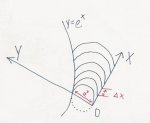Consider the region bounded by y = ex, the x-axis, the y-axis, and the line x = 3. A solid is created so that the given region is its base and cross-sections perpendicular to the x-axis are semi-circles. Set up a Riemann sum and then a definite integral to find the volume of the solid.
a) What is the volume of a slice perpendicular to the x-axis? (Use Deltax for x as necessary.)
b) What is the exact volume of the solid?
for a) i said (pi)(e^(2x))Deltax which is wrong
for b) i said [integral from 0 to 3] of (pi)(e^(2x))dx which is also wrong
how do i solve this?
a) What is the volume of a slice perpendicular to the x-axis? (Use Deltax for x as necessary.)
b) What is the exact volume of the solid?
for a) i said (pi)(e^(2x))Deltax which is wrong
for b) i said [integral from 0 to 3] of (pi)(e^(2x))dx which is also wrong
how do i solve this?

